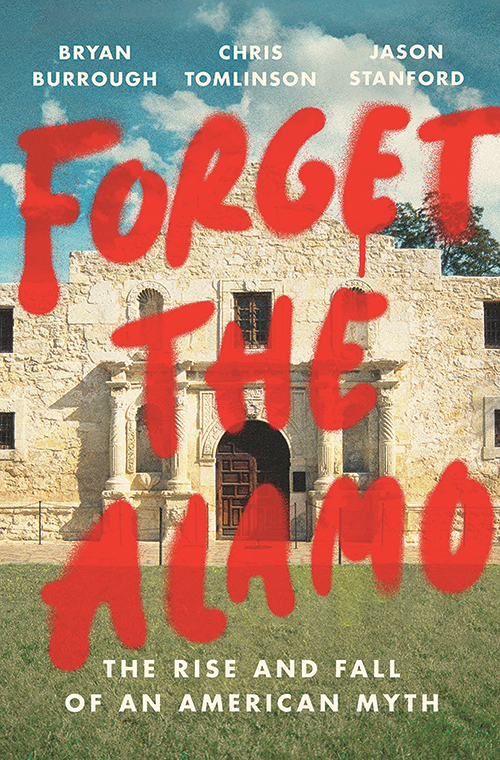
Forget the Alamo: The Rise and Fall of an American Myth
Reviewed by J. E. McNeil
March 1, 2022
By Bryan Burrough, Chris Tomlinson, and Jason Stanford. Penguin Press, 2021. 416 pages. $32/hardcover; $13.99/eBook.
One of the reasons I love reading histories is that they are almost always eye-opening: I learn that something was way more complicated or way simpler than I knew—or both. Forget the Alamo, a good and thoughtful read, was both.
Understand that I was born and raised in Texas and had multiple years of Texas history. In the fifth grade (1960), I found Mobil Oil’s Texas History Movies, a comic book history with snide asides. I learned of Sam Houston’s bigamy (it didn’t count because she was Cherokee), the Cherokees naming him “Big Drunk,” and his departure from Tennessee in disgrace. Jim Bowie, a drunk, came to Texas with a warrant on his tail. Davy Crockett was a braggart and a failed politician. Moses and Stephen F. Austin, father and son, were your basic land developers, not much different from today. Many Tejanos (Latino Texans) were significant players in the Texas Revolution but were immediately subjected to racism by Southern mercenaries called to save “liberty” from Mexico. So, my vision of the Texas Revolution was never starry-eyed. I never admired Crockett or Bowie. My heroes were William B. Travis and Houston. I have read Travis’s letter “To the People of Texas & All Americans in the World” dozens of times in the Alamo.
The three authors (one Texan by birth, two Texans by choice) try to debunk the myths surrounding the Texas Revolution. This book takes you step-by-messy-step alongside Mexicans, Tejanos, and Texians to the Alamo: the needless deaths of its “heroes” and days thereafter to the Battle of San Jacinto. The Alamo was not a delay tactic to allow Houston to get ready to confront Santa Anna; this was Travis and Bowie not believing reports that Santa Anna was coming until it was too late.
It was primarily recent immigrants (hoping to make their fortunes after a few adventures) who sent letters throughout Texas and the United States that claimed there was “tyranny” when they were asked to obey the laws of Mexico, their adopted country. Mexico was a country that was trying to quell a rush of immigrants who spoke a different language from crossing a river (the Neches). Many of these immigrants were just steps ahead of creditors or the law. Travis, who had deserted his wife, became one of the loudest voices crying “tyranny” and led various military forays against Mexican troops before the revolution. Ironically, Crockett, having lost a U.S. Congressional race, came to Texas seeking political fortune only days before meeting Bowie at the Alamo; by dying there, he became synonymous with its glory. The book looks at the possibility that the U.S. military and President Andrew Jackson were, from the beginning, trying to gain control of the cotton growing lands of East Texas. One piece of evidence is that U.S. soldier deserters came in mass with cannons and returned to the U.S. military with nominal or no punishment for their desertion.
Rather than a mad power grab by Santa Anna (second only to Hitler in Texan minds), it was a land grab by Anglos seeking riches as plantation owners in the cotton boom. Santa Anna acceded everything to the Texian citizens of Mexico that they had asked for, except one thing: he refused to allow Texians to enslave Black people, which had been illegal in Mexico since 1829. So Anglo immigrants had their “servants” sign 99-year contracts, but Santa Anna saw through that system. Tyranny!
All of Stephen F. Austin’s trips to the Mexican government were to save the institution of slavery. Anglo colonists were fighting for their property—the enslaved—rather than against tyranny over personal liberty. The Texas Revolution was fought in the name of manifest destiny and liberty, but it was really about slavery.
The book recounts the canonization of the Alamo. Houston used it to rally his troops, no doubt. But over time, as so often happens, the significance of the event is enhanced, and the details are blurred. The contributions of Tejanos were forgotten. The foibles of the “heroes” were whitewashed in popular history. Stories (of dubious origins) of individual martyrs’ deaths within the Alamo were embellished. The value of the delay they supposedly provided so Houston could gather his troops was puffed up. The rapes and brutality of the Texas soldiers in retaliation for the Alamo and Goliad are forgotten.
An effort to preserve the remains of the Alamo began in the 1890s. In the 1950s, children all over the United States could sing Davy Crockett and Jim Bowie theme songs. Coonskin caps were the rage. Now the culture wars rage in Texas over the complicated beginnings of the Texas Revolution.
I no longer revere Travis, and Houston has been diminished in my eyes. But the thing that most affected me was how, after all that I knew about the shadiness of many of the heroes of the Texas Revolution, the racism of many Anglo immigrants, and later the mercenaries, I did not understand that the battle was simply about enslavement.
Which goes to show how embedded racism is.
J. E. McNeil is a member of Friends Meeting of Washington D.C., a practicing lawyer for more than 40 years, and a sixth-generation Southerner still trying to recover from her racist upbringing.


